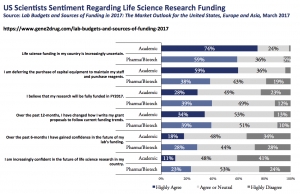Scientists on Funding & Spending Plans for 2017
The health of the life science tools industry is directly tied to the annual investments in research and development made by governments, private industry and investors. The economic climate, political pressures, societal needs and technology will all affect the outlook for laboratory spending on life science research, drug discovery and development in 2017.
Despite an improving global economy, the life science industry begins 2017 in state of uncertainty. We have just released Lab Budgets and Sources of Funding in 2017: The Market Outlook for the United States, Europe and Asia to help provide clarity in these uncertain times. The report is based on a survey of more than 1,000 life scientists who answered a detailed questionnaire about their budget and spending plans for 2017. I hope you’ll visit our website for a complimentary Executive Summary and complete Table of Contents.
The U.S. election and the UK’s decision to leave the European Union have contributed greatly to the market’s uncertainty. In the U.S. the FY 2017 budget calls for $34.1 billion for the NIH and $7.5 billion for the NSF and this level of spending is likely to remain in place under the current continuing resolution. The real test, however, came in March as the new administration unveiled its FY2018 budget that included a 20% cut in NIH funding. At the same time, President Trump has been critical of the pharmaceutical industry and has promised to subject pharmaceutical companies to a competitive bidding process to lower drug prices that in turn could cause a decrease in profits and R&D spending.
The sentiment of life science customers – especially in academia – ranges from pessimistic to downright gloomy. In response to one of our questions, one U.S. based researcher wrote:
“We are at risk for a society in which “alternative facts” supplant real facts. When the truth becomes whatever we want, then there’s little motivation to pay for science that may tell us something we don’t want to hear. The current political environment goes beyond being ambivalent to science and swings toward anti-science. I anticipate that government funds for research will stagnate or decline. If the VA is privatized, I anticipate that VA-funded research may disappear entirely as most healthcare systems are not in the business of conducting research. I fear we are embarking on a major setback for science in this country that will continue to affect us for years beyond the current administration. Young researchers like me are dropping out of the academic race. Funding is too tight. The sure bet is on the established researcher, and that makes sense financially, until those researchers retire in a couple decades. I anticipate we’ll be without mid-career researchers at that time.”
We asked a series of agreement scale questions to quantify customer sentiment. Here’s the US response:
The situation is much the same in Europe. The U.K. will remain part of the E.U for another two years but Brexit has cast a pall over pan-European research collaborations and the work status of European scientists working in U.K. labs. The government of Prime Minister Theresa May has promised to spend an extra £4.7 billion on R&D between now and 2020–21, and the final year’s £2-billion boost will represent an increase of almost 20% in total government R&D spending. Less clear, however, is how these funds will be allocated due to a restructuring of the way British research is organized, or how much will support basic life science research. The proposed increase may still not be enough to offset the impending loss of E.U. research grants from the Horizon 2020 program.
It’s not just UK scientists who are impacted, one Chinese scientist told us:
“Brexit has led to uncertainty, and in fact, I was planning on moving to the U.K. to accept a position there. With Brexit, all of this has been placed on hold – and I am staying in Hong Kong for the foreseeable future. Funding is still available and this is a local opportunity, particularly with regards to venture capital.”
Indeed Asian scientists had a far more positive outlook than their US and European counterparts. Asian markets in general, and China in particular, are likely to grow in 2017. Although the Chinese economy has slowed down over the last several years, the country’s commitment to scientific research remains strong. According to Nature, China now invests more in scientific research than the entire E.U. and Chinese researchers feature on around one-fifth of the world’s most-cited papers. Japan remains stagnant but Singapore and South Korea continue to grow with both public and private sector investments in life science.
These macroeconomic trends directly affect the budgets of individual laboratories. Lab Budgets and Sources of Funding in 2017: The Market Outlook for the United States, Europe and Asia explores projected 2017 lab budgets by region, market segment and the implications of these findings for the life science tools market. Not to be alarmist but see how US scientists answered this question on the best and worst cases for their lab’s budget for FY2017:
This unique report details the percent of lab budgets allocated for instrumentation and consumables. Spending for both instrumentation and consumables is then presented for 10 broad sub-categories including:
- Cell based analysis
- Genome analysis
- Protein analysis
- General lab equipment
- Cell-based analysis kits and reagents
- Genome analysis kits and reagents
- Protein purification and separation kits and reagents
- Live animals
- General laboratory chemicals, plasticware, glassware and disposables
The insights contained in this report will enable senior management to forecast demand, fine-tune projections, and set goals and allocations for 2016. In these uncertain times, we need all the clarity we can get.







